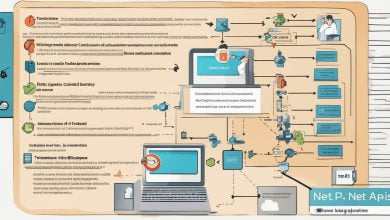
RESTful Web Services have become the backbone of modern API development. They offer a flexible and scalable approach to building web applications and services. Understanding this technology is essential for developers looking to create dynamic and efficient APIs. In this article, we will explore the fundamentals of RESTful Web Services, the best practices for designing and managing them, and the challenges and solutions associated with this technology.
We will cover the basics of resource-oriented and service-oriented architecture, HTTP methods used in API development, and the differences between JSON and XML data serialization. We will also discuss strategies for optimizing and troubleshooting RESTful Web Services, as well as security measures to protect against potential threats.
If you want to stay ahead of the curve and build better, faster, and more secure APIs, this article is for you. Let’s dive in and master RESTful Web Services together!
Key Takeaways
- RESTful Web Services provide a flexible and scalable approach to building web applications and services.
- Understanding resource-oriented and service-oriented architecture is essential for designing effective RESTful APIs.
- Strategies for optimizing, troubleshooting, and securing RESTful Web Services can significantly enhance their overall performance and efficiency.
Understanding RESTful Web Services
RESTful Web Services are a popular way of building APIs to communicate between different applications. The architecture is based on the idea of treating everything as a resource and manipulating these resources using HTTP methods.
The Resource Oriented Architecture (ROA) is a key component of RESTful Web Services. It focuses on identifying resources in the API and designing them using a consistent naming convention. The URI of the resource is used to uniquely identify it, and the HTTP methods used to manipulate the resource.
HTTP Methods form a critical part of RESTful API development. The GET method is used to retrieve a resource, while the POST method is used to create a new resource. Similarly, PUT, DELETE, and PATCH methods are used to update, delete, and modify resources, respectively.
The ROA and HTTP methods are the building blocks of RESTful API development. By following these principles, developers can create scalable, maintainable, and efficient APIs that can communicate with a wide range of applications.
Designing RESTful APIs
RESTful API design is crucial for delivering high-quality web services. By following web services best practices, developers can design efficient and reliable APIs that meet business and user needs.
Proper Resource Representation
One of the key principles of RESTful API design is proper resource representation. Resources should be represented using a unique URI that identifies them uniquely. The URI should also include the resource’s metadata, such as creation and modification dates.
When designing RESTful APIs, it is also important to provide accurate documentation that clearly defines the available resources and their usage. This helps developers understand how to interact with the API, reducing errors and enhancing usability.
URI Structure
The URI structure should be designed in such a way that it accurately represents the resource hierarchy. The URI should be intuitive and easy to read, allowing developers to quickly understand the resource structure and the relationships between them.
When designing the URI structure, it is essential to avoid using query strings for operational parameters and instead use HTTP methods. This makes the API more predictable and easier to test and maintain.
Error Handling
Proper error handling is essential for delivering reliable and effective RESTful APIs. Developers should include error handling mechanisms that provide developers with clear and understandable error messages. These messages should include error codes, descriptions, and recommended actions for resolving the error.
Error responses should be appropriate to the request type made, such as 4xx errors for client-side errors and 5xx errors for server-side errors. This makes the API more predictable and easier to troubleshoot in case of errors.
Managing RESTful Web Services
Managing RESTful Web Services can be a challenging task, especially in API Development. Service Oriented Architecture emphasizes the importance of looking at APIs as a collection of services that can be combined to create a complete solution.
To ensure the smooth functioning of APIs, it is important to build them with scalability and maintainability in mind. This involves effective use of HTTP caching, identifying performance bottlenecks, and implementing measures to improve API efficiency.
In addition to that, managing RESTful Web Services requires a deep understanding of APIs and the ability to troubleshoot them effectively. Thorough testing, documentation, and monitoring can be useful in identifying and resolving issues that arise.
Finally, taking a proactive approach towards security is crucial for managing RESTful Web Services. This involves using secure communication protocols, implementing access control mechanisms, and ensuring that sensitive information is encrypted.
Serializing Data with JSON and XML
Serialization is the process of converting data structures or objects into a format that can be stored or transmitted. In the case of RESTful web services, serialization is essential for exchanging data between the client and the server. JSON and XML are popular formats used to serialize data in RESTful web services. Understanding the differences and usage of these formats can help you optimize your API performance.
JSON
JSON, short for JavaScript Object Notation, is a lightweight data format that is easy for humans to read and write and for machines to parse and generate. It is a text format that is based on key-value pairs, making it an ideal format for representing complex data structures. One of its main advantages is that it is supported in almost all modern programming languages and is widely used in web development.
The basic structure of a JSON object consists of a key-value pair enclosed in curly braces, with individual pairs separated by commas. Here’s an example of a simple JSON object:
{“name”: “John”, “age”: 30, “city”: “New York”}
JSON data is also supported in RESTful web services through the HTTP “Accept” and “Content-Type” headers. When a client sends a request to a server, it can include an “Accept” header specifying that the response should be in JSON format. The server can also specify the format of the data it is returning using the “Content-Type” header.
XML
XML, short for Extensible Markup Language, is another popular format used to serialize data in RESTful web services. Unlike JSON, XML uses tags to define the structure of the data, making it more flexible and extensible. It is a text-based format that is similar to HTML, making it easy to read and write by humans.
The basic structure of an XML document consists of a root element that contains child elements, which can contain other child elements or text. Here’s an example of a simple XML document:
<person>
<name>John</name>
<age>30</age>
<city>New York</city>
</person>
Similar to JSON, XML data can also be exchanged between clients and servers in RESTful web services using the “Accept” and “Content-Type” headers.
When deciding which format to use, it’s important to consider factors such as performance, ease of use, and compatibility with existing systems. Both JSON and XML have their strengths and weaknesses, and the choice ultimately depends on the specific use case and requirements of your application.
Optimizing RESTful Web Services
Optimizing the performance and efficiency of RESTful Web Services is critical to ensure smooth API development. Here are some best practices to follow:
Implement Caching
To improve the speed of your APIs, caching is a reliable technique. It can help reduce server load and minimize data transfer by enabling frequently accessed resources to be stored locally. Utilizing caching mechanisms such as browser caching, reverse proxy caching, and content delivery network (CDN) caching can enhance the API’s response time and speed up client-side rendering.
Use Compression
Compressing responses using gzip, deflate, or other similar algorithms can significantly reduce the size of transmitted data. This technique can minimize network latency and boost the API’s overall performance. However, keep in mind that compression can increase the load on the server, so balance the benefits with the potential for added workload.
Optimize URI Structure
Designing URI structures that are clear and meaningful can improve the API’s usability and enhance its SEO performance. Proper URI structuring can also help manage resource representation and make it easier to modify the API function while maintaining backward compatibility.
Follow Web Services Best Practices
Adhering to web services’ best practices such as standard HTTP methods, proper resource representation, and error-handling strategies can help optimize the API’s performance by avoiding unnecessary processing overhead. These best practices can also help improve the API’s readability, consistency, and maintainability in the long run.
By implementing these strategies, you can improve the performance and efficiency of your RESTful Web Services, ensuring smooth API development and better user experience.
Troubleshooting RESTful Web Services
Despite best efforts, developers sometimes encounter issues when working with RESTful Web Services. Here are some common problems and how to troubleshoot them:
1. HTTP Errors
HTTP errors can occur due to various reasons such as invalid requests, incorrect authentication, server issues, or network problems. Developers can use tools like Postman or Fiddler to inspect requests and responses to identify the specific issue. Once identified, the issue can be resolved by making the necessary changes to the request or backend services.
2. Cross-Origin Resource Sharing (CORS) Errors
CORS errors occur when a browser restricts a web page from making requests to a different domain. This can be resolved by adding the Access-Control-Allow-Origin header to the response. This header specifies which domains are allowed to access the resource.
3. Authentication and Authorization Errors
Authentication and authorization errors can occur due to invalid or expired tokens, incorrect credentials, or insufficient permissions. Developers can troubleshoot these errors by examining the authentication and authorization flow and verifying the validity of tokens and credentials. Implementing proper error handling and logging can also help in identifying and resolving these errors.
By understanding and troubleshooting these common issues, developers can ensure the seamless functioning of RESTful Web Services, leading to overall successful API development.
Security in RESTful Web Services
Security in RESTful Web Services is paramount for API Development. Adhering to Web Services Best Practices will ensure that APIs are designed with security in mind from the outset. This includes implementing authentication measures and access controls to protect API endpoints from unauthorized access and malicious attacks.
One of the primary methods of securing RESTful Web Services is through the use of tokens or keys, which authenticate the API requester. Tokens can be generated for each individual user or application, providing secure access to specific API endpoints. Access controls can also be implemented to restrict access to sensitive data and maintain confidentiality.
Another Best Practice is to encrypt sensitive data in transit and at rest. Secure Sockets Layer (SSL) or Transport Layer Security (TLS) protocols can be used to establish a secure connection between the API endpoint and the requester. Additionally, encrypting data at rest using technologies such as Advanced Encryption Standard (AES) ensures data remains confidential even in the event of a security breach.
Regular monitoring and testing of RESTful Web Services is also essential for maintaining security. This includes vulnerability scanning, penetration testing, and regular code reviews to ensure the API is free from potential threats. By following these Best Practices, developers can ensure the security and integrity of their RESTful Web Services.
Conclusion
In conclusion, mastering RESTful Web Services is vital for any developer looking to excel in API development. Through this article, we have explored key concepts such as resource-oriented architecture and HTTP methods while also highlighting best practices for designing, managing, optimizing, troubleshooting, and securing RESTful APIs.
It is crucial to invest time and effort in continuous learning to stay abreast of changes and advancements in the field of RESTful Web Services. By doing so, developers can create efficient and effective web services that meet the needs of the end-users while also protecting sensitive data.
Remember, a well-designed RESTful API is the cornerstone of a successful web service. By implementing the strategies and techniques discussed in this article, developers can ensure that their APIs are scalable, secure, and provide an exceptional user experience.
We hope that this article has provided valuable insights and guidance to those seeking to master RESTful Web Services. Remember to continue learning and applying the best practices of RESTful API design to ensure success in API development.
FAQ
Q: What are RESTful Web Services?
A: RESTful Web Services are a type of web services that follow the principles of Representational State Transfer (REST) architectural style. They use HTTP methods to perform operations on resources, providing a stateless and scalable approach to building APIs.
Q: What is resource-oriented architecture?
A: Resource-oriented architecture is an architectural style that focuses on modeling systems as a collection of resources. In the context of RESTful Web Services, resources represent entities such as users, products, or orders, and are accessed using unique and uniform resource identifiers (URIs).
Q: What are the HTTP methods used in RESTful Web Services?
A: RESTful Web Services commonly use four main HTTP methods: GET, POST, PUT, and DELETE. GET is used to retrieve data, POST is used to create data, PUT is used to update existing data, and DELETE is used to remove data.
Q: What are some best practices for designing RESTful APIs?
A: Some best practices for designing RESTful APIs include proper resource representation, using meaningful and hierarchical URIs, supporting multiple data formats such as JSON and XML, and employing consistent error handling and status codes.
Q: How can RESTful Web Services be optimized?
A: RESTful Web Services can be optimized by implementing caching mechanisms, compressing data transfers, using efficient data serialization formats like JSON, reducing unnecessary network round trips, and adopting performance testing and monitoring tools.
Q: What are common troubleshooting issues with RESTful Web Services?
A: Common troubleshooting issues with RESTful Web Services include incorrect resource URLs, authentication and authorization problems, server errors, handling of invalid requests, and handling of rate limiting or throttling.
Q: What security measures should be considered in RESTful Web Services?
A: Security measures in RESTful Web Services include implementing proper authentication mechanisms like OAuth or API keys, restricting access based on authorization roles, encrypting sensitive data using HTTPS, and regularly updating and patching server and framework vulnerabilities.








